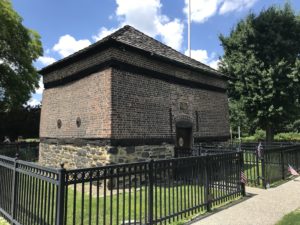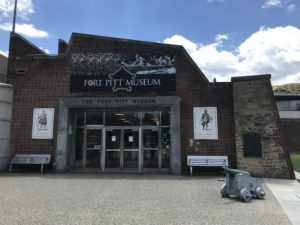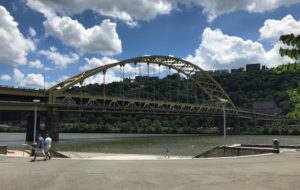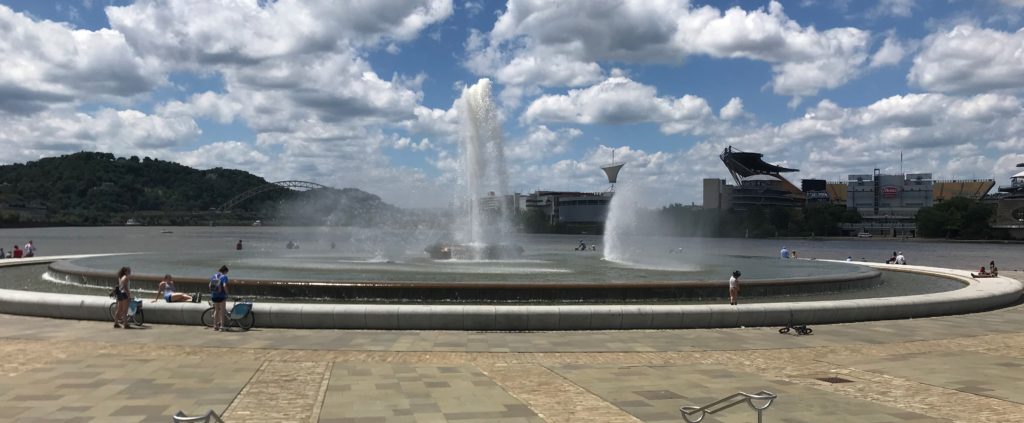When we went to Pittsburgh last week we intended to visit Point State Park first. But after driving by it twice with two detours across rivers, we realized there was no parking at Point State Park. None at all. I’ve never seen a state park before that didn’t have any parking. So we headed to Heinz History Center and enjoyed the low cost parking there. We also asked the guy at the information desk about parking for the park. He said he usually just walked because it was only a mile to the park from the History Center.
With that assurance, after we were done at the Heinz History Center we walked down Penn Avenue to Point State Park. We had three reasons for wanting to visit Point State Park. First, it was where Pittsburgh began. Second, it was the site of three French and Indian War Forts. Third, it is at the confluence of the Monogahela and Allegheny Rivers – the start of the Ohio River.
 The earliest history of Pittsburgh begins at Point State Park. It served as an encampment for Native Americans. A British trader, William Trent, established a trading post there in 1740. In 1754, realizing the importance of the confluence for the Ohio country, the British built a small, wooden fort here. The French immediately came (the day after the British finished the fort) and burned it down. Then the French built a much larger fort called Fort Duquesne. They occupied this fort in a position of power for most of the French and Indian War. The soldiers that defeated Washington at Fort Necessity came from Fort Duquesne.
The earliest history of Pittsburgh begins at Point State Park. It served as an encampment for Native Americans. A British trader, William Trent, established a trading post there in 1740. In 1754, realizing the importance of the confluence for the Ohio country, the British built a small, wooden fort here. The French immediately came (the day after the British finished the fort) and burned it down. Then the French built a much larger fort called Fort Duquesne. They occupied this fort in a position of power for most of the French and Indian War. The soldiers that defeated Washington at Fort Necessity came from Fort Duquesne.
Washington had his revenge, however. After the British were defeated in trying to take the fort several times, Washington succeeded in capturing it. It helped that the French had abandoned the fort and burned it down the day before he got there. The British replaced Fort Duquesne with the larger Fort Pitt. This fort became important in settler expansion into the Ohio country and in protecting the settlers during several Native American uprisings.
 Today Point State Park preserves this history in a lovely green space on the point between three rivers. We visited the Fort Pitt Museum first. The admission was included in our admission to the Heinz History Center (bonus!). This was a nice little museum, with some wonderful artwork and interesting timeline of the French and Indian War. We saw some of the earthworks and the original brick walls of the fort. A blockhouse is preserved just outside the museum.
Today Point State Park preserves this history in a lovely green space on the point between three rivers. We visited the Fort Pitt Museum first. The admission was included in our admission to the Heinz History Center (bonus!). This was a nice little museum, with some wonderful artwork and interesting timeline of the French and Indian War. We saw some of the earthworks and the original brick walls of the fort. A blockhouse is preserved just outside the museum.
 Then we walked to the point and took in the beautiful view of the city, the rivers, and the fountain at the point. We saw a riverboat sail by and admired some of the bridges of the city. The houses across the Monogahela River are perched precariously on the heights overlooking the river. It was easy to see Heinz Field across the Allegheny River. We could also see both of the inclines that are a favorite things for tourists to do. The Great Allegheny Passage, a 150 mile bike trail, begins at Point State Park, so there were a lot of bike riders.
Then we walked to the point and took in the beautiful view of the city, the rivers, and the fountain at the point. We saw a riverboat sail by and admired some of the bridges of the city. The houses across the Monogahela River are perched precariously on the heights overlooking the river. It was easy to see Heinz Field across the Allegheny River. We could also see both of the inclines that are a favorite things for tourists to do. The Great Allegheny Passage, a 150 mile bike trail, begins at Point State Park, so there were a lot of bike riders.
 We found the marker for Fort Duquesne and looked at the concrete outline around it. I wonder if the soldiers appreciated the great view they had. Then we headed back up Penn Avenue to the truck.
We found the marker for Fort Duquesne and looked at the concrete outline around it. I wonder if the soldiers appreciated the great view they had. Then we headed back up Penn Avenue to the truck.
We enjoyed our visit to Pittsburgh and are glad we went. But the horrible traffic and difficult parking will keep us from visiting again. Pittsburgh, especially the “golden triangle” is a beautiful, busy, and revitalized place to visit.

